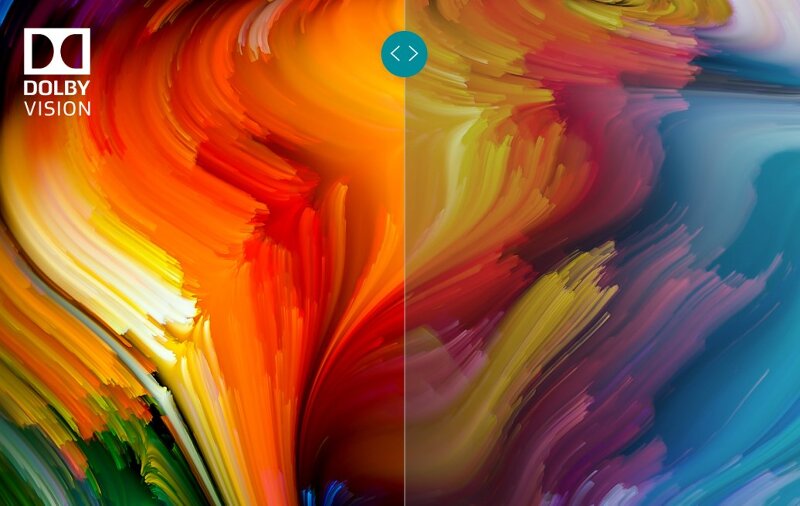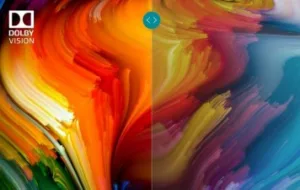In the beginning, which was 2015, more-or-less ordinary consumers began their encounter with high-dynamic-range (HDR) media through the theatrical release of Dolby Vision movies. “Tomorrowland” was the first. Such media must be recorded or created with darker darks and brighter brights, and the the signal processing throughout the entire cinema/video/transmission/decoding/display chain must support the high dynamic range and render the luminance and color levels accurately.
In 2015, television sets adhered to the BT.709 standard, which supported a modestly respectable color gamut and a maximum luminance of 100 nits, now called standard dynamic range (SDR). HDR TVs are now widely available at very modest price points, but even if you have one you will see lots of programming in SDR because that’s the way it’s sent to you. (Even the gloss on Megyn Kelly’s lips doesn’t need more than 100 nits.) For comparison, an inexpensive notebook PC or desktop monitor is likely to produce 250-300 nits. SDR performance is so important for even today’s premium TV sets that a large percentage of the viewing tests performed in the Value Electronics Premium TV Shootout we report on each year are devoted to SDR.
So Hollywood creative types started producing movies with up to 1000-nit luminance peaks (HDR1000), are now in some cases up to HDR4000, and in moments of reefer madness dream of HDR10K. What happens when a scene with 1000-nit content drives your 500-nit-maximum, non-HDR TV? The system doesn’t know the capabilities of your set and sends the full 1000 nits. The set cannot reproduce anything more than 500 nits so all content between 500 and 1000 nits is presented as a uniformly bright 500 nits. All detail between 500 and 1000 is lost, and a dramatically important detail such as sunlight reflecting off a sniper’s telescopic sight will not be there. The target’s subsequent dropping to the ground and rolling away would then seem completely illogical even though the director had carefully laid the groundwork.
 Samsung wasn’t permitting photographs in its Innovation Room, so here’s a pretty but otherwise rather useless comparison of a Dolby Vision image with an SDR version, which appears on Dolby’s Website. The image was clipped from my monitor, which has a maximum luminance of 300 nits and does not claim to be HDR, and nobody is claiming a calibrated signal chain from my computer to Meko’s publishing offices in the U.K. and on to your screen, which is almost certainly not HDR and has an unknown luminance (at least to me). Still, it’s pretty. (Image: Dolby Laboratories, cropped by Ken Werner)
Samsung wasn’t permitting photographs in its Innovation Room, so here’s a pretty but otherwise rather useless comparison of a Dolby Vision image with an SDR version, which appears on Dolby’s Website. The image was clipped from my monitor, which has a maximum luminance of 300 nits and does not claim to be HDR, and nobody is claiming a calibrated signal chain from my computer to Meko’s publishing offices in the U.K. and on to your screen, which is almost certainly not HDR and has an unknown luminance (at least to me). Still, it’s pretty. (Image: Dolby Laboratories, cropped by Ken Werner)
With HDR10 — the basic HDR protocol supported by all HDR phones, TV sets, monitors, and the HDR media intended for them — metadata is sent along with the media to inform the device of the medium’s maximum and minimum luminance levels. The set’s luminance capability is stored in the set electronics, and a standard electooptical transfer function (EOTF) is invoked which brings the medium’s maximum luminance down to the maximum capability of the device. The viewer can now see that flash of sunlight off the sniperscope.
This process of mapping light and dark tones to be within the range of the TV set (or other device) is called, logically enough, tone mapping.
Problem solved, right? Not quite. The limitation of HDR10 and other early EOTFs is that they are based on fixed metadata. That is, the metadata sent with the film applies to the entire film, even those scenes that have no content over 500 nits. These scenes also have their tonal range compressed by half (in our example), so the tonally mapped dynamic range must be rendered by fewer luminance levels. This produces not only an unnecessarily compressed dynamic range, but also an increased chance of banding and loss of detail. Technology giveth and technology taketh away.
Enter dynamic metadata, which provides the needed individual information for each scene (and even each frame). This is much better. Scenes with very bright highlights are tone-mapped to the capabilities of the TV set and dark scenes can keep their full dynamic range. First with a broadly commercialized solution was Dolby Laboratories with Dolby Vision. A Dolby white paper describes its display manager.
“The display manager is tuned for the target display device: it knows the maximum and minimum brightness, color gamut, and other characteristics of that device. Metadata that accompanies the full-range Dolby Vision video signal carries information about the original system used to grade the content and any special information about the signal. Using this metadata, the display manager intelligently transforms the full-range signal to produce the best possible output on the target device.
A major difference between the Dolby Vision approach and other HDR solutions is the metadata that accompanies each frame of the video all the way to the display manager in the consumer-playback device. Systems with generic HDR carry only static metadata that describes the properties of the color-grading monitor that was used to create the content and some very basic information about the brightness properties (maximum and average light levels) for the entire piece of content. Dolby Vision adds dynamic metadata that is produced during content creation; the dynamic properties of each scene are captured. With this information, the Dolby Vision display manager is able to adapt the content to the properties of the display much more accurately. It allows hues to be preserved properly, which is critical for display of skin tones. Even with mass market edge-lit TVs, the overall impression of colors is preserved much more accurately.”
Many of today’s HDR TV sets support both HDR10 and Dolby Vision. But not Samsung’s. Samsung decided around 2017 to develop the non-proprietary static-metadata HDR10 into an open-source dynamic-metadata system they would call HDR10+. At the time, Samsung said they were doing this to: 1) be able to adjust various parameters and EOTFs, which they could not do with Dolby’s proprietary closed-box system; and 2) to avoid paying Dolby’s license fee, which Dolby estimates to be $3.00 per set in its white paper.
In addition to Samsung and Panasonic (both founding members, along with the studio 20th Century Fox, of the HDR10+ Alliance), supporters of HDR10+ include Philips, Hisense, TCL, Qualcomm, and Oppo and Pioneer for some disc players. Some companies support both HDR10+ and Dolby Vision.
Almost from the beginning, Samsung’s HDR10+ initiative met with skepticism, doubt, and scorn, mostly of the “you can’t make a silk purse out of a sow’s ear” sort, but also because of Samsung’s history of bludgeoning accepted industry terminology and technology with its marketing clout. (Remember “LED TV” and “QLED”?) But… But…
In the invitation-only Samsung Innovation Room at CES, company representatives and partners directly compared a 1000-peak-nit signal running on a high-end QLED set with the same signal tone-mapped to two mid-range TVs, one running Dolby Vision and one running HDR10+. Both systems brought the 1000-nit peaks down to maximum luminance of the lesser sets, but under the ambient illumination in the Innovation Room and on the material Samsung had chosen to show us, HDR10+ generally did generally show more detail in the tone-mapped images.
Florian Friedrich (CEO, FF Pictures GmbH, and Chair of ICDM’s HDR Subcommitee), who is a respected TV image quality expert as well as a long-time Samsung collaborator, said the difference stems from HDR10+ using 10-point Bezier curves in its EOTF instead of the 3-point S curves used by Dolby Vision since the Bezier curves allow a more refined mapping of signal to luminance.
I was impressed. Of course it’s possible that Dolby could select material that would make Dolby Vision look better than HDR10+, and I would like to see that demonstration. But Samsung made an effective case that HDR10+ is competitive with Dolby Vision, and might even be the better tone mapper.
Of course, I hope the good people at Dolby will comment. (KW)
Ken Werner is Principal of Nutmeg Consultants, specializing in the display industry, manufacturing, technology, and applications, including mobile devices, automotive, and television. He consults for attorneys, investment analysts, and companies re-positioning themselves within the display industry or using displays in their products. He is the 2017 recipient of the Society for Information Display’s Lewis and Beatrice Winner Award. You can reach him at [email protected] or www.nutmegconsultants.com.

